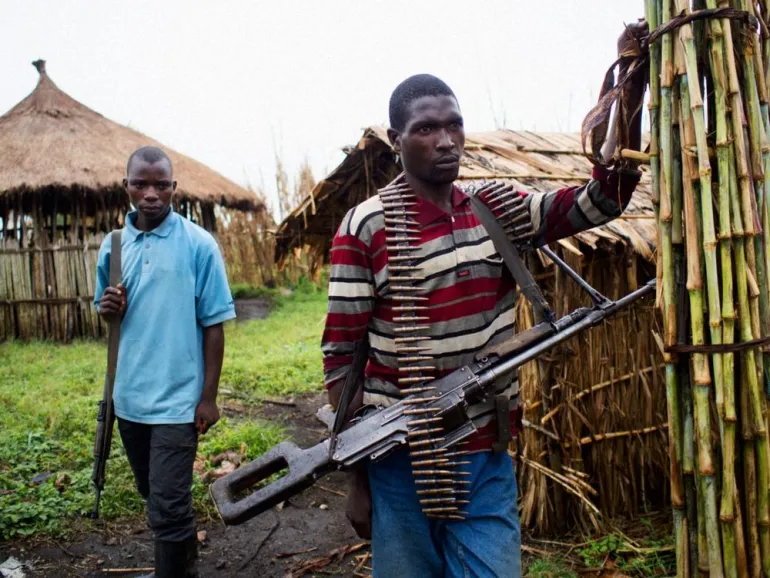Russian 🇷🇺 armed forces started their first strategically important maneuver of 2025.
After months of preparation, Russian army is trying to cut the Pokrovsk-Kostiantynivka frontline, breaching the Donbass 🇺🇦 front in the middle.
🧵THREAD🧵1/16⬇️
After months of preparation, Russian army is trying to cut the Pokrovsk-Kostiantynivka frontline, breaching the Donbass 🇺🇦 front in the middle.
🧵THREAD🧵1/16⬇️

After months of struggle west of Pokrovsk and in Toretsk, russian army switched its offensive potential to the Ocheretyne frontline.
After a striking progress of nearly 10km 3 weeks ago, they are now pushing north, farther than the Pokrovsk-Kostiantynivka highway.
After a striking progress of nearly 10km 3 weeks ago, they are now pushing north, farther than the Pokrovsk-Kostiantynivka highway.
Russian army captured in a few days Myrolyubivka, Malynivka, Nova Poltavka, Novoolenivka and Oleksandropil. This fast advance allowed them to get through an important fortified line on the Pokrovsk-Kostiantynivka highway. 

Russian army entrance into Myrolyubivka also shows they want to continue north to Novoekonomichne to further enter Myrnorhod or encircle Pokrovsk from the west.
This long waited manoeuver by russian forces may be strategically important at the scale of the battle in Donbass.
They could continue north to Droujkivka, significantly cutting Pokrovsk and Dnipropetrovsk oblast from Kostiantynivka and Kramatorsk. (map @UAControlMap )
They could continue north to Droujkivka, significantly cutting Pokrovsk and Dnipropetrovsk oblast from Kostiantynivka and Kramatorsk. (map @UAControlMap )

After this progress, multiple hypothesis could happen. The most evident would be an offensive from the heigh ground to Droujkivka and Kostiantynivka, forcing a large ukrainian retreat from central Donbass and preparing the battle for Kramatorsk. 

Alternatively or at the same time, russian forces could try to encircle Pokrovsk or taking Dobropilla, a significant supply hub in western Donetsk oblast.
This particular progress could be followed by an infiltration in Pokrovsk after an isolation from the west.
This particular progress could be followed by an infiltration in Pokrovsk after an isolation from the west.

What about fortifications ?
We can still find approximately two lines of anti-tank ditches and multiple trenches, however not enough. The western and northern Pokrovsk axis are more defended.
We can still find approximately two lines of anti-tank ditches and multiple trenches, however not enough. The western and northern Pokrovsk axis are more defended.

Anyway, russia will soon have to deal with larger fortifications, especially barbed wire and big ditches against infantry.
Ukrainian engineering units are switching from large to small and more numerous trenches. It is too early to see any result.
Ukrainian engineering units are switching from large to small and more numerous trenches. It is too early to see any result.

In parallel, russian army is set to enter Dnipropetrovsk oblast in the coming weeks, after a long delaying operation on the Novopavlivka frontline. 

Also, on the Vovotcha frontline, russian forces are consolidating their positions in Bahatyr and will face only two last towns, Komar and Odradne before reaching the rivers junction. 

The most recent russian progression between the towns of Kostiantynivka and Pokrovsk also allows drone teams to target the Dobropilla-Kramatorsk highway, threatening supplies to the "capital city" of ukrainian controlled donbass.
https://x.com/wartranslated/status/1924083611940093960
One year ago, russian forces seyzed Ocheretyne and made large progress between Pokrovsk and Kourakhove during the summer until december.
This year, Russia will try to do it again, this time in the north, and faster, if they want to conquer a city this time.
This year, Russia will try to do it again, this time in the north, and faster, if they want to conquer a city this time.

Now, lets get to a more general overview.
Russian army has a superior manpower (some say more than 30 000 recruits a month allowing them to wage the trench war.
Ukrainian forces lack men and switch to a more flexible defense.
Russian army has a superior manpower (some say more than 30 000 recruits a month allowing them to wage the trench war.
Ukrainian forces lack men and switch to a more flexible defense.

On a larger scale, the war is extending to the long ukrainian-russian border at full scale, meaning both sides nead to move more troops there. The advantage is russian everywhere and ukrainian defense is mainly done by drones, obstacles and trench warfare. 

The negociations are not advancing because Russia does not want to negociate. They showed what they wanted in Istanbul, nothing changed since 2022, while they control less territory.
I will soon analyse those negociations. Thanks for following !
I will soon analyse those negociations. Thanks for following !
• • •
Missing some Tweet in this thread? You can try to
force a refresh




















